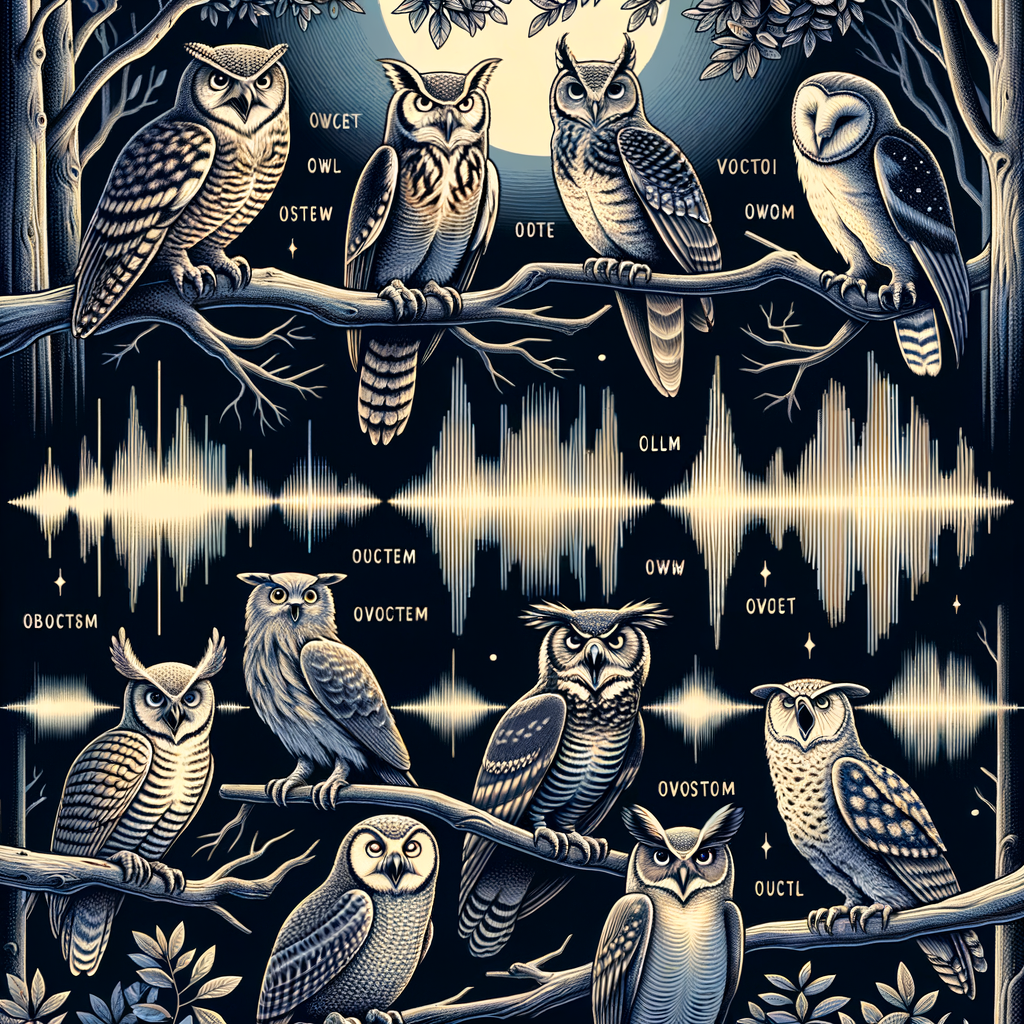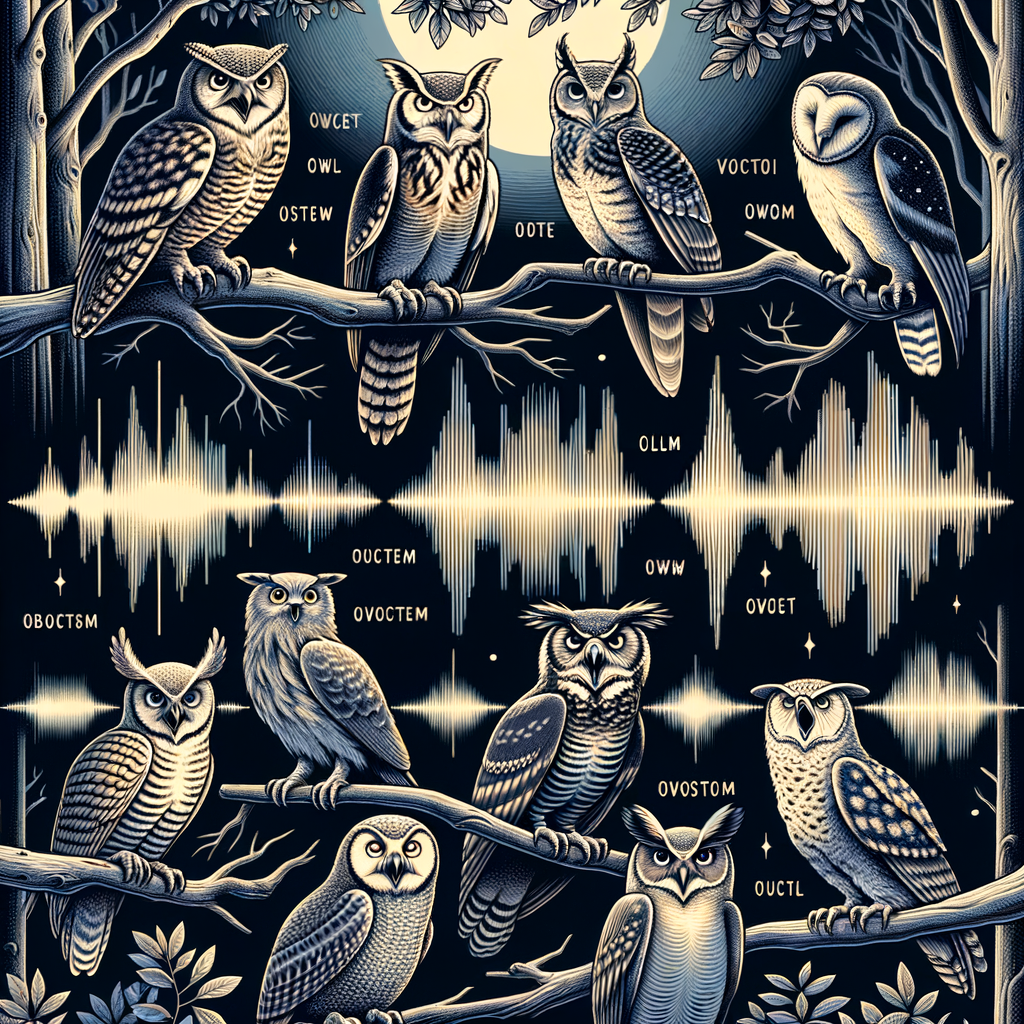
Introduction to Owl Call Identification
- Importance of owl call identification: Understanding owl calls is crucial for bird watchers, researchers, and nature enthusiasts. It helps in tracking owl populations, studying their behavior, and conserving their habitats. Recognizing these calls can also enhance your outdoor experience, making it more engaging and educational.
- Overview of different owl species sounds: Owls have unique calls that vary by species. For example, the Great Horned Owl is known for its deep hoots, while the Barn Owl produces a screeching sound. Learning these differences can help you identify which owl is nearby just by listening.
Owl Vocalizations
Owls are fascinating creatures, and their calls are just as intriguing. Understanding their vocalizations can help us learn more about these mysterious birds.
-
Common types of owl vocalizations:
- Hoots: The most well-known owl sound. It is deep and rhythmic.
- Screeches: High-pitched and sharp, often used by younger owls.
- Whistles: Soft and melodic, usually heard during the mating season.
- Barks: Short and abrupt, often used as a warning signal.
-
Owl call characteristics:
- Pitch: The highness or lowness of the sound. For example, screeches are high-pitched.
- Duration: How long the call lasts. Hoots can be long and drawn out.
- Pattern: The rhythm of the call. Some owls have a distinct pattern like “hoo-hoo-hoo.”
- Volume: How loud the call is. Barks are usually loud and sharp.
By learning these vocalizations, you can identify different owl species and understand their behaviors better. For more detailed information, you can visit the Owl Wikipedia page.
Identifying Owls by Sound: A Detailed Guide
Owl Call Guide: Common Species
- Barn OwlA unique screeching call. It sounds like a long, harsh scream. This call can be heard at night when the owl is hunting.
- Great Horned OwlKnown for its deep, soft hoots. These hoots often come in a series of three to eight notes. They are most active at dusk and dawn.
- Barred OwlCall sounds like “Who cooks for you? Who cooks for you all?” It is a series of hoots that are easy to recognize. You can hear them in forests and near water.
- Screech OwlIt sounds like a high-pitched whinny. These calls are often heard in wooded areas at night.
Owl Call Guide: Rare Species
-
Snowy Owl
Known for its beautiful white feathers. It lives in the Arctic and is rarely seen in other places. Its call is a deep, booming sound that can be heard over long distances.
Interesting Fact: Snowy Owls are one of the heaviest owl species. They can weigh up to 6.5 pounds!
Feature Details Habitat Arctic regions Call Deep, booming sound Weight Up to 6.5 pounds Learn more about the Snowy Owl on Wikipedia.
-
Elf Owl
The smallest owl in the world. It lives in the deserts of North America. Its call sounds like a high-pitched whinny, similar to a small dog.
Interesting Fact: Elf Owls are so small that they can fit inside a soda can!
Feature Details Habitat Deserts of North America Call High-pitched whinny Size 5-6 inches tall Learn more about the Elf Owl on Wikipedia.
-
Northern Hawk Owl
A rare sight in North America. It prefers cold, forested areas. Its call is a rapid, high-pitched trill that sounds like a whistle.
Interesting Fact: The Northern Hawk Owl can spot prey from half a mile away!
Feature Details Habitat Cold, forested areas Call Rapid, high-pitched trill Vision Can spot prey from half a mile away Learn more about the Northern Hawk Owl on Wikipedia.
Nocturnal Bird Calls: Beyond Owls
While owls are famous for their hoots, many other birds also sing at night. Learning to identify these calls can be exciting and rewarding.
- Identifying other nocturnal bird calls:Many birds sing at night, including nightjars, whip-poor-wills, and corncrakes. Each has a unique call that sets them apart. For example, the nightjar’s call sounds like a rapid “churring,” while the whip-poor-will repeats its name in a clear, loud song.
Listening carefully and noting the pattern and pitch can help you identify these birds. You can also use apps or websites that provide recordings of bird calls to practice.
- Comparison between owl calls and other nocturnal bird calls:Owl calls are often deep and resonant, like the great horned owl’s “hoo-hoo-hoo” sound. In contrast, other nocturnal birds may have higher-pitched or more repetitive calls. For instance, the corncrake’s call is a repetitive “crex crex,” which is quite different from an owl’s hoot.
Understanding these differences can help you distinguish between an owl and another nocturnal bird. The more you listen, the better you’ll get at identifying these calls.
| Bird | Call Description |
|---|---|
| Great Horned Owl | Deep, resonant “hoo-hoo-hoo” |
| Nightjar | Rapid “churring” |
| Whip-poor-will | Repeats its name in a clear, loud song |
| Corncrake | Repetitive “crex crex” |
By learning these calls, you can enjoy the night sounds and know which birds are around. Happy bird listening!
Owl Hoot Recognition: Practical Tips
Recognizing owl hoots can be a fun and rewarding activity. Here are some practical tips to help you identify these nocturnal birds by their calls.
- Listening carefully to the rhythm and pitch: Each owl species has a unique call. Pay attention to the rhythm and pitch. For example, the Great Horned Owl has a deep, stuttering hoot, while the Eastern Screech-Owl has a trilling call.
- Noting the time and place of the call: Owls are most active at night. Keep track of when and where you hear the calls. Some owls prefer forests, while others might be found in open fields or near water.
- Using owl sound guides and apps: There are many resources available to help you identify owl calls. Apps like Merlin Bird ID and websites like Wikipedia provide sound clips and detailed descriptions.
Case Studies: Owl Call Identification in Practice
-
Case Study 1: Identifying the Elusive Snowy Owl
The Snowy Owl is known for its beautiful white feathers and haunting calls. In this case study, researchers used audio recordings to track and identify Snowy Owls in the wild.
Key Insights:
- Snowy Owls have a deep, booming call that can be heard over long distances.
- They are often found in open areas like tundras and fields.
- Using sound alone, researchers were able to locate these owls even in low visibility conditions.
According to a study, Snowy Owls’ calls can be heard up to 10 kilometers away in optimal conditions (Wikipedia).
-
Case Study 2: Distinguishing Between the Calls of the Barn Owl and the Barred Owl
Barn Owls and Barred Owls can be tricky to tell apart by sight, but their calls are quite different. This case study focuses on how birdwatchers and scientists differentiate between these two species using their vocalizations.
Key Insights:
- Barn Owls have a screeching call that sounds like a long, harsh scream.
- Barred Owls, on the other hand, have a distinctive hooting call that sounds like “Who cooks for you? Who cooks for you all?”
- By learning these calls, birdwatchers can identify these owls even at night when they are most active.
Studies show that Barred Owls’ calls are often louder and more rhythmic compared to the screeching calls of Barn Owls (Barn Owl, Barred Owl).
Key Takeaways on Identifying Owls by Their Calls
- Importance of patience and practice:
Learning to identify owls by their calls takes time. You need to listen carefully and often. Owls do not always call on command. Sometimes, you may need to wait for a long time before you hear one. Practice makes perfect. The more you listen, the better you will get at recognizing different owl calls. - Value of a good owl call guide:
Having a reliable guide can be very helpful. A good guide will have recordings of different owl calls. It can also provide information about where and when you are likely to hear each type of owl. Some guides even include tips on how to mimic owl calls to attract them. - Role of technology in bird call identification:
Technology can make identifying owl calls easier. There are apps available that can help you identify bird calls. You can record the call you hear and the app will try to match it to a known owl call. This can be very helpful, especially for beginners. Additionally, websites like Wikipedia offer valuable information about different owl species and their calls.
| Key Insight | Details |
|---|---|
| Patience and Practice | Listen often and wait for owls to call. |
| Good Owl Call Guide | Use guides with recordings and tips. |
| Technology | Use apps and websites to help identify calls. |






